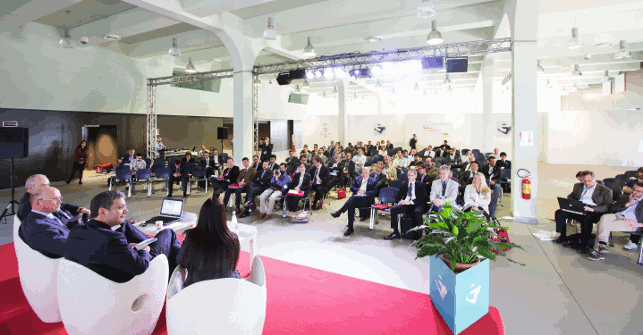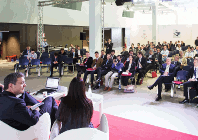As the complexity of product design increases, so do the number of tools used in the design process, yet the time-to-market is ever decreasing.

modeFRONTIER International Users’ Meeting 2014, which took place in Trieste, Italy
Against this background the modeFRONTIER user meeting in Trieste, Italy, organised by the Italian provider of this tool Esteco, set out to show the vast array of different industries using its tool to optimise designs and using it as a means of presenting design choices, quickly.
‘Mastering complexity’ was the tagline of the event, and given the multifarious calculations being tamed by Esteco’s software, it proved apt.
Tools of the trade
modeFRONTIER is Esteco’s collaborative environment tool for large dataset Computer Aided Engineering (CAE).
Open to accepting data from almost all mainstream CAD, simulation and analysis software, it is used in projects as diverse as urban towers and domestic washing machines.
It allows an engineer, for example, to pull in a CAD model from Catia, CFD analysis from Ansys, a set of calculations from MathCAD and an Excel spread sheet of bill of materials.
The user defines the various parameters, the limits they can operate within and the goals that need to be achieved with the optimised design. The system (along with the required computational power) will then provide a curve of points representing the range of optimised designs.
modeFRONTIER sets out to corral the complex variety of possibilities from the available engineering data and visually packages the results – giving engineers a graph of precise data, while keeping it simple enough for boardroom decision makers to understand and use.
To make it available to project collaborators it has a secure web-based platform, Somo, which also helps with two big issues for such a tool – computational power and software licenses.
Somo’s Grid system provides the user with a network of workstations for processing power, but still runs the controlling software from its native load computer, eliminating the need for a sole workstation to be loaded with every tool that’s used.
Even with the Grid system, it takes time to run vast numbers of variables through a computer with finite power.
This is overcome through a ‘virtual’ version of the data, which modeFRONTIER creates from the inputted fields, which enables it to run at a much higher speed.
Yan Fu, a technical expert at Ford, explained how a new Enterprise Multi-disciplinary Design Optimisation System (EMDO ) is being used at the company, which provides a collaborative and distributed execution platform to manage the complexity of growing demands of large-scale vehicle design projects.
Perfect solutions?
Optimisation is just as much about making informed choices and trade-offs as it is about reaching perfection.
Rarely in the real world is there a truly perfect design – for instance, optimising the weight of a design to save money on materials could backfire if it demands a more complex and expensive manufacturing process.
A round-table discussion by the automotive sector formed one of the event’s highlights, with speakers from Jaguar Landrover (JLR), Ford and Volvo all explaining how modeFRONTIER is used now, and how they expect its role to evolve.
Currently problems include the late manufacture of a vehicle, which can cost £2million each day of the delay. However, this can be resolved using optimisation.
Decision-making in such situations needs to be as fast as possible and the ability to speedily re-calculate options using virtual optimisation can prevent huge losses.
More standard stages of design benefit from optimisation directly. As a representative from JLR explained, the company managed to lose 400kg of aluminium from the chassis of its latest SUV by combining CAD models and various simulation and analysis data.
Yet optimisation is gradually moving from being simply a problem-solving tool to influencing the initial design concepts.
Nowadays, engineers are not trying to solve one problem at a time. Tools such as modeFRONTIER enable several concepts to run in parallel, which allows teams to make the right design earlier.
By weeding out flawed designs earlier, by the time a design reaches physical prototyping less needs to be built for testing.
The earlier that optimisation is introduced into the workflow, the more useful it can be, and those who control design and manufacture are beginning to appreciate the benefits.
As one attendee explained, it has meant that, for the first time, the boardroom of his company had understood the expanded benefits of simulation tools.
In a complex world of algorithms and engineering data, it’s easy to see why having a tool to simply guide the decision process is beginning to bring CAE to the attention of company heads.
//player.vimeo.com/video/101298040?title=0&byline=0&portrait=0

Report from modeFRONTIER International Users’ Meeting 2014
Default






